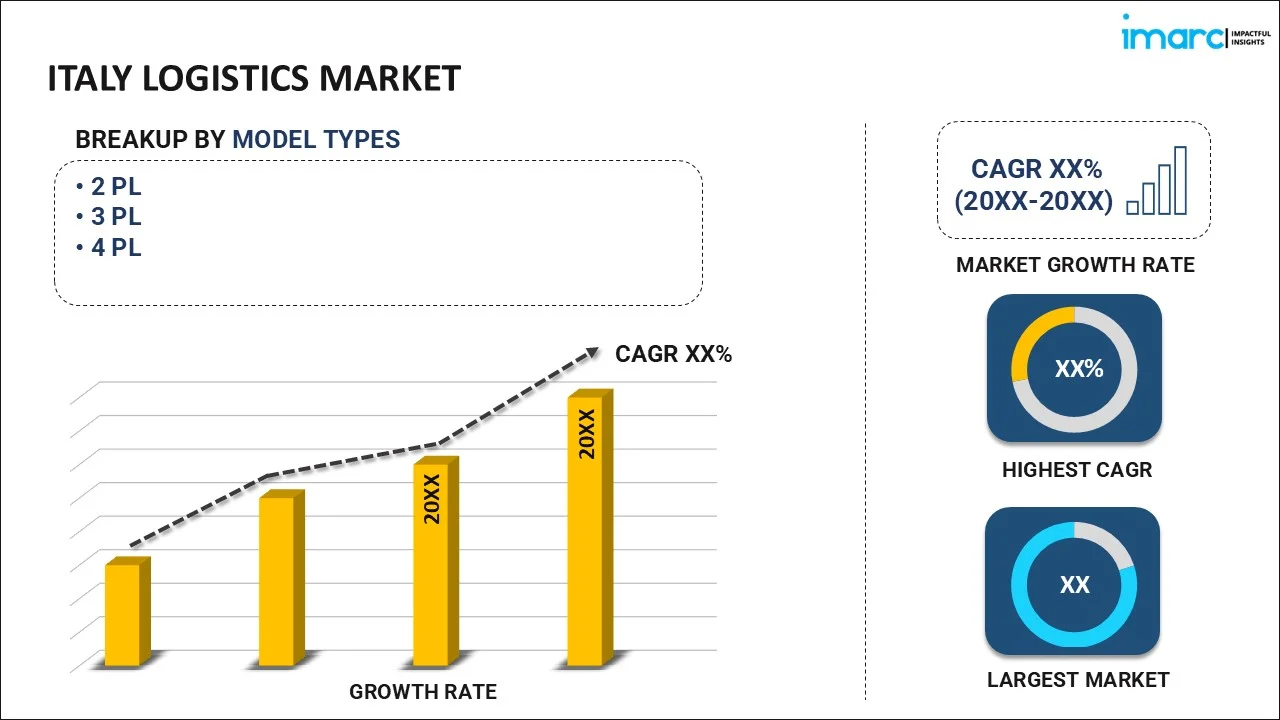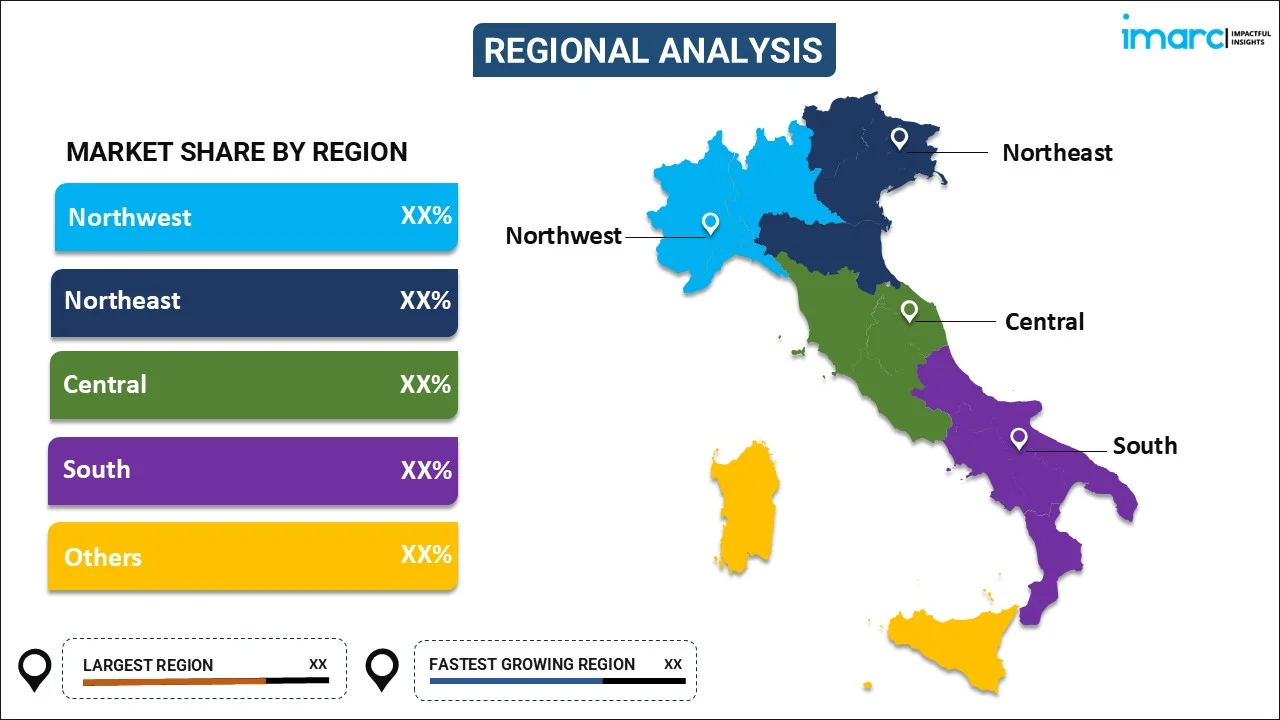
Italy Logistics Market Size, Share, Trends and Forecast by Model Type, Transportation Mode, End Use, and Region, 2025-2033
Italy Logistics Market Overview:
The Italy logistics market size reached USD 125.40 Billion in 2024. Looking forward, IMARC Group expects the market to reach USD 191.50 Billion by 2033, exhibiting a growth rate (CAGR) of 4.47% during 2025-2033. Rising e-commerce demand, expansion of 3PL services, increasing automation and AI in warehousing, government investments in infrastructure, growing cold chain logistics, sustainability initiatives, and strong international trade are driving the growth of the Italy logistics market.
|
Report Attribute
|
Key Statistics
|
|---|---|
|
Base Year
|
2024
|
|
Forecast Years
|
2025-2033
|
|
Historical Years
|
2019-2024
|
| Market Size in 2024 | USD 125.40 Billion |
| Market Forecast in 2033 | USD 191.50 Billion |
| Market Growth Rate (2025-2033) | 4.47% |
Italy Logistics Market Trends:
Expansion of E-commerce and Last-Mile Delivery Services
The boom in e-commerce has revolutionized the logistics sector in Italy at its very core, giving rise to the ever-growing demand for effective last-mile delivery. Greater demand from consumers for online shopping necessitates efficient and fast delivery systems, which compel logistics companies to adjust. The online market is projected to generate $72.90 billion in revenue by 2025. With an estimated CAGR of 8.46% from 2025 to 2029, it is expected to reach $100.88 billion by 2029. To address the increasing demand, heavy investments are being pumped into last-mile delivery infrastructure. In Q2 2023, Italy saw €258 million invested in logistics, with much of the investment going towards improving last-mile abilities. This concentration is intended to minimize delivery time and enhance the quality of services in cities. Besides this, firms are now embracing cutting-edge technologies to maximize last-mile delivery. For example, in December 2024, Amazon made its inaugural drone delivery in Italy, which was a huge breakthrough in autonomous delivery solutions. These innovations will be able to simplify operations and lower costs in the logistics industry.
Infrastructure Development and Modernization
Italy's geographical position as a crossing between Europe, Asia, and Africa requires an advanced and solid logistics infrastructure. Sensing this need, the government of Italy has initiated huge infrastructural development work to raise the efficiency and capabilities of its logistics system. With the National Recovery and Resilience Plan (NRRP), Italy has pledged USD 8.9 billion through 2026 to modernize the ports and infrastructure. This investment is meant to enhance maritime logistics capacity, ensuring easier international trade and making Italy a focal logistics hub in the Mediterranean area. Some notable projects are the USD 115.28 million development of the Port of Ancona, which began in December 2023. This project has a 3.3 km transport link with two tunnels and a viaduct that enhances the link between maritime and land transport. Moreover, there are plans to demarcate high-speed and conventional rail tracks in cities by 2028 to decrease congestion and improve freight efficiency. These infrastructure upgrades are anticipated to support the growth of the logistics market. In addition, better infrastructure will allow for quicker and more efficient transportation, drawing more investment and promoting economic growth.
Italy Logistics Market Segmentation:
IMARC Group provides an analysis of the key trends in each segment of the market, along with forecasts at the region/country level for 2025-2033. Our report has categorized the market based on model type, transportation mode, and end use.
Model Type Insights:

- 2 PL
- 3 PL
- 4 PL
The report has provided a detailed breakup and analysis of the market based on the model type. This includes 2 PL, 3 PL, 4 PL.
Transportation Mode Insights:
- Roadways
- Seaways
- Railways
- Airways
A detailed breakup and analysis of the market based on the transportation mode have also been provided in the report. This includes roadways, seaways, railways, and airways.
End Use Insights:
- Manufacturing
- Consumer Goods
- Retail
- Food and Beverages
- IT Hardware
- Healthcare
- Chemicals
- Construction
- Automotive
- Telecom
- Oil and Gas
- Others
The report has provided a detailed breakup and analysis of the market based on the end use. This includes manufacturing, consumer goods, retail, food and beverages, IT hardware, healthcare, chemicals, construction, automotive, telecom, oil and gas, and others.
Regional Insights:

- Northwest
- Northeast
- Central
- South
- Others
The report has also provided a comprehensive analysis of all the major regional markets, which include Northwest, Northeast, Central, South, and others.
Competitive Landscape:
The market research report has also provided a comprehensive analysis of the competitive landscape. Competitive analysis such as market structure, key player positioning, top winning strategies, competitive dashboard, and company evaluation quadrant has been covered in the report. Also, detailed profiles of all major companies have been provided.
Italy Logistics Market News:
- January 2025: QT Real Estate announced the acquisition of Blackstone's logistics assets in Milan and Verona for €230 million. The portfolio contains 12 completely leased buildings totaling 265,000 square meters.
- January 2025: GXO Logistics extended its agreement with Versace, the legendary luxury fashion brand, to manage omnichannel logistics for all of the company's product lines. Over time, the relationship expanded to include new distribution channels and product categories.
Italy Logistics Market Report Coverage:
| Report Features | Details |
|---|---|
| Base Year of the Analysis | 2024 |
| Historical Period | 2019-2024 |
| Forecast Period | 2025-2033 |
| Units | Billion USD |
| Scope of the Report |
Exploration of Historical Trends and Market Outlook, Industry Catalysts and Challenges, Segment-Wise Historical and Future Market Assessment:
|
| Model Types Covered | 2 PL, 3 PL, 4 PL |
| Transportation Modes Covered | Roadways, Seaways, Railways, Airways |
| End Uses Covered | Manufacturing, Consumer Goods, Retail, Food and Beverages, IT Hardware, Healthcare, Chemicals, Construction, Automotive, Telecom, Oil and Gas, Others |
| Regions Covered | Northwest, Northeast, Central, South, Others |
| Customization Scope | 10% Free Customization |
| Post-Sale Analyst Support | 10-12 Weeks |
| Delivery Format | PDF and Excel through Email (We can also provide the editable version of the report in PPT/Word format on special request) |
Key Questions Answered in This Report:
- How has the Italy logistics market performed so far and how will it perform in the coming years?
- What is the breakup of the Italy logistics market on the basis of model type?
- What is the breakup of the Italy logistics market on the basis of transportation mode?
- What is the breakup of the Italy logistics market on the basis of end use?
- What are the various stages in the value chain of the Italy logistics market?
- What are the key driving factors and challenges in the Italy logistics?
- What is the structure of the Italy logistics market and who are the key players?
- What is the degree of competition in the Italy logistics market?
Key Benefits for Stakeholders:
- IMARC’s industry report offers a comprehensive quantitative analysis of various market segments, historical and current market trends, market forecasts, and dynamics of the Italy logistics market from 2019-2033.
- The research report provides the latest information on the market drivers, challenges, and opportunities in the Italy logistics market.
- Porter's five forces analysis assist stakeholders in assessing the impact of new entrants, competitive rivalry, supplier power, buyer power, and the threat of substitution. It helps stakeholders to analyze the level of competition within the Italy logistics industry and its attractiveness.
- Competitive landscape allows stakeholders to understand their competitive environment and provides an insight into the current positions of key players in the market.
Need more help?
- Speak to our experienced analysts for insights on the current market scenarios.
- Include additional segments and countries to customize the report as per your requirement.
- Gain an unparalleled competitive advantage in your domain by understanding how to utilize the report and positively impacting your operations and revenue.
- For further assistance, please connect with our analysts.
 Request Customization
Request Customization
 Speak to an Analyst
Speak to an Analyst
 Request Brochure
Request Brochure
 Inquire Before Buying
Inquire Before Buying




.webp)




.webp)












